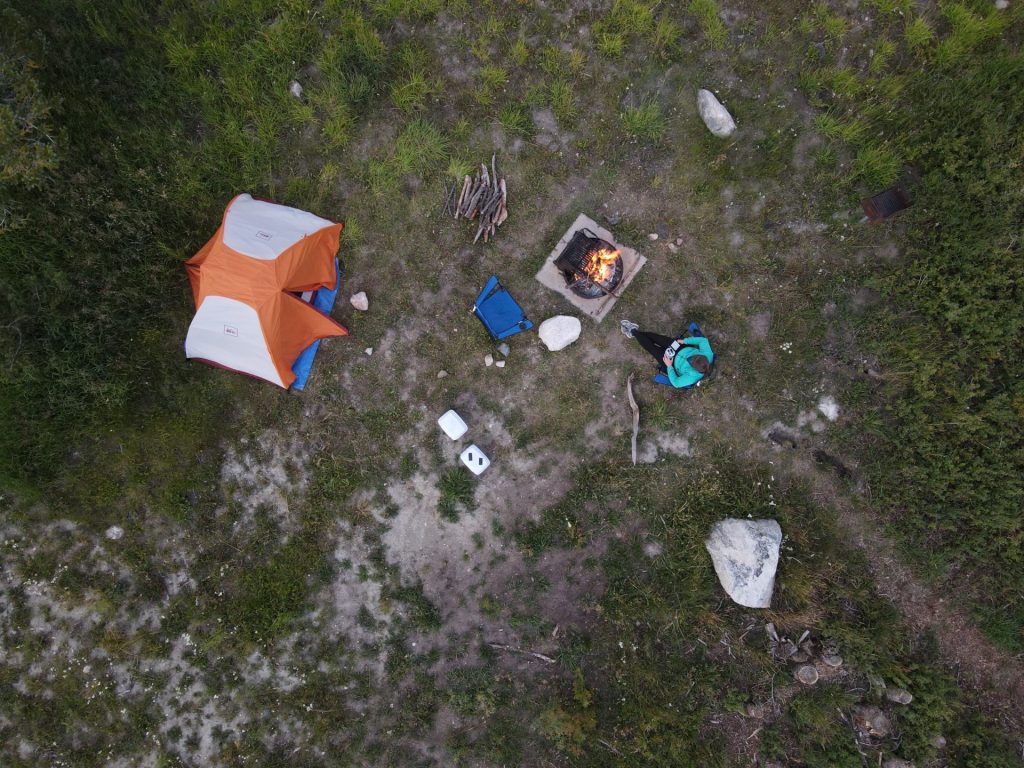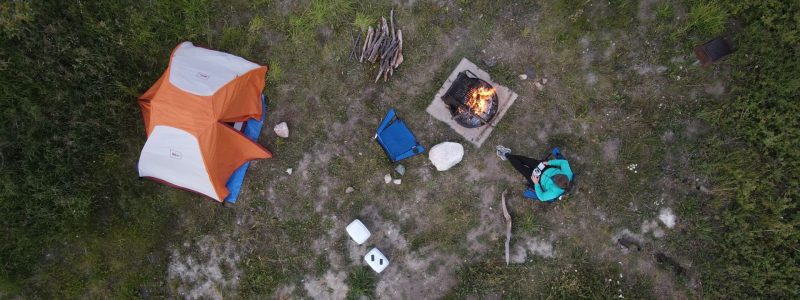WOC’s 2026 Calendar Contest is live! Join Major and other artists by submitting visual art that illustrates The Lands Between Us — the public lands we all hold in common. To submit your art, tag it with the hashtag #WOCCalendarContest on Instagram, or email it to claire@wyomingoutdoorcouncil.org.
For more information about the contest, visit our calendar contest page.
Major and Nancy King have been visiting the Snowies — the colloquial name for the Snowy Range about 30 miles west of Laramie — almost every year since the 1980s. For them, the mountain range, its numerous lakes and ponds, and the prolific wildflowers, offer the couple a place of respite — to “get away,” they both said repeatedly.
Major was a winner of 2025 Calendar Contest, and his photo, an aerial of his wife reading amid their camp, captures what they mean when they talk about the history they’ve shared with the area over the years.
On the afternoon the winning photograph was taken, the couple had just returned to their site in the Nash Fork Campground after a hike. They had started a fire, and Nancy had sat down to relax and read. “That’s what I like to do,” she said, “while Major, he likes to fly.”
By flying, she means drones. Photography has always been a hobby and profession for Major, a retired video journalist, most recently at Channel 7 out of Denver. But lately, he’s been particularly taken with drone photography.
“I started flying drones the year the Federal Aviation Administration came out with their regulations to make them legal,” he said. That was in 2016, and he’s been flying commercially and recreationally ever since.
“It not only gives you a sense of freedom, but a chance to see the world from a vantage point that most people don’t get,” he said. “And I love sharing that with people.”

There’s a more somber side to Major’s photography — and the couple’s excursions to the Snowies — though. Back in the day, their beloved Nash Fork campground was wrapped in the dark timber of a heavy, healthy forest. But over the years, they watched as the trees died. This was due to a devastating infestation of bark beetles — which lay eggs under the bark of many Western pine species, killing the trees. The bark beetle epidemic wiped out most of the mature lodgepole pines in northern Colorado and southern Wyoming in the early 2000s, turning the forests gray and causing the closure of campgrounds and recreation sites across the region, including Nash Fork.
Nash Fork in particular was hard hit, sitting at the confluence of two types of trees — lodgepole and spruce — as well as two invading beetles — the spruce and the mountain pine. The Forest Service had to close Nash Fork for nearly 10 years due to the amount of deadfall caused by beetle kill and the potential hazards the dead trees posed for campers and visitors.
The Forest Service and a local nonprofit called Common Outdoor Ground teamed up to make the campground habitable again in July 2021 after years of clearing trees from the sites to ensure safety for future campers — the Kings, included.
When the Kings were able to return to Nash Fork, they were elated. On this afternoon in 2023, they did what they had done so often there over the years — Nancy pulled out a book, while Major took to the sky to immerse himself in the aerial perspective of a place he’s grown to love.
“It was a somewhat crowded weekend at the campground,” he remembers. “I could see our neighbors, but I was also able to capture Nancy experiencing a moment of solitude from above. In a nutshell, that photo tells the story of why we keep coming back here: the solitude, the chance for reflection.”
Long before the Kings made their first visit to the Medicine Bow Routt National Forest, which is home to the Snowies, the area was known as a place for Tribal gathering and medicine making, according to the Forest Service. The name Medicine Bow comes from the Indigenous tribes (including the Eastern Shoshoni, Cheyenne, Arapaho, Oceti Sakowin, and Crow) who inhabited southeastern Wyoming. In the lush mountain valleys, the tribes harvested quality mountain mahogany to make bows and would gather in the area to hold cultural celebrations and assemble bows together. This became known as “medicine making” and “making bow” to the early settlers, and thus the forest was later named.
The way Major and Nancy talk about this area in southcentral Wyoming, it seems to offer the couple a bit of medicine, too. They talked about the wonder of the mother moose who frequently wanders through their campsites, the carpets of flowers that extend to the horizon, the mirrored surface of the lakes, the wide open feeling as the land continues on as if forever, the night skies so clear you can see not only myriad clusters of stars, but the distant glow of Wyoming’s small cities, and the blue agate, shell fossils and quartz they find at their feet.
“Wyoming just has such stunning beauty everywhere,” Major said. “The raw beauty is just amazing, that’s what I love about it. You can still get lost in Wyoming, figuratively and literally.”
Lost in a book, lost in the view through a camera lens, lost in the best kind of way, in peace and beauty.

